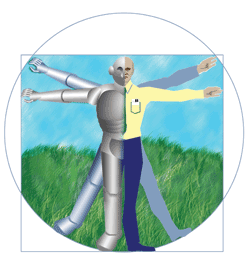Cyborgs – really?
I think of all the fictional robots out there, one of the most feared was the Terminator. The Terminator (Model T-101) was an almost unstoppable killing machine. It had an organic layer that hid its robotic form. It could make logical decisions (for a killer robot) and move like a human. We are far from a world of cyborgs. But, unlike C-3P0, the Terminator moved with the fluid motion of a human one of the main reasons it could move among humans so easily.
There have been many developments to make robots look human, but many of them don’t have the fluid motion and gracefulness of a living creature. I think that’s why the first time I saw the work being done by Boston Dynamics, I was amazed. If you haven’t seen the videos on BigDog and Petman, my guess is you don’t have Internet access.

What is most amazing about these robots is their remarkable behavior mobility, agility, dexterity, and speed. The Petman robots have the shape and size of a human, making them the first anthropomorphic robots that move dynamically like a real person. When walking, they actually step heel to toe and, if shoved, can correct their balance to stay upright.
Robots that function and move like living things are starting to find a home. The LS3 from Boston Dynamics solves an important military problem; it reduces the load soldiers must carry in combat missions on difficult terrain. It will not need a driver, because it will automatically follow a leader using computer vision or travel to designated locations using sensing and GPS.
“If LS3 can offload 50 lbs from the back of each soldier in a squad, it will reduce warfighter injuries and fatigue and increase the combat effectiveness of our troops,” said Marc Raibert, president of Boston Dynamics and principal investigator for the program. “The LS3 program shows just how serious DARPA and the Marine Corps are about building practical, legged robots to offload our dismounted troops.”
We are far from cyborgs coming into existence, but the realistic movements of some robots is amazingly eerie. The Terminator: 0.99% Possibility
Industrial Robots
If you read the first part of this Viewpoint in March, you may have been thinking, what the heck is he talking about? Avatar was about an alien planet with indigenous people that connected with other living things in a giant network of living matter. So what better to create the chaos than a human in a robotic suit that can be used for harvesting the natural resources of a planet as well as for a private army. Awesome!
Well, awesome for making movies, but what is the reality behind it? Humans with amplified powers due to robotic suits are nothing new (Iron Man is the first thing that jumps to my mind), nor is the use of industrial robots, such as robotics arms, automated harvesting machines, etc. The U.S. military has been looking into robotic exoskeleton suits for a long time.
DARPA’s Exoskeletons for Human Performance Augmentation program has issued grants for various projects such as the Raytheon Sarcos XOS exoskeleton suit. Built from a combination of sensors, actuators, and controllers, the robotic suit fits around the wearer’s arms, legs, and back. The XOS enables a user to easily carry a man on his back or lift 200 lbs several hundred times without tiring, and yet it is also agile enough to let its wearer kick a soccer ball or punch a speed bag with ease.
There are other suits out there, mainly designed to help with rehabilitation. But the biggest issue with all the robotic suits right now is power. They either have a very limited power source or they need to be tethered to the power source.
Robotic suits are getting there.
Avatar robot suit: 90% Possibility
While we may not see all of our favorite robots moving among us in the next decade, one thing is certain: Each day scientists and engineers bring us one step closer. At the end of the day, the creative minds behind the fiction inspire robotics developers and, in turn by sharing their research, developers help creators of fiction give us a peek at the future.
Bryan DeLuca To comment on this Viewpoint, go to eebeat.com
Advertisement
Learn more about Electronic Products Magazine





